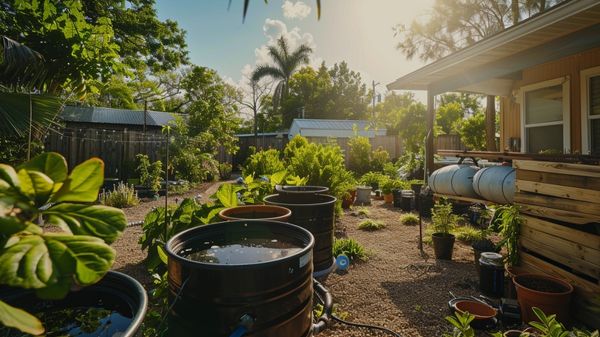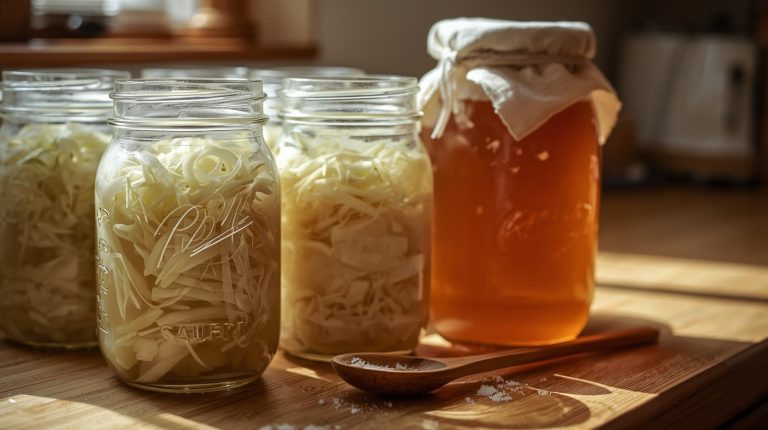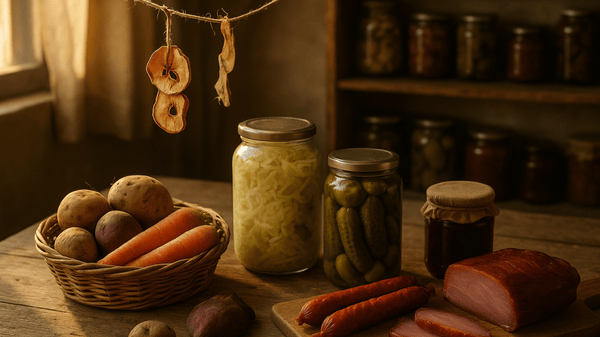When you’re in dire need of water, knowing how to generate it efficiently is life-saving. You can collect rainwater using clean containers positioned under downspouts to maximize efficiency, ensuring they’re covered to reduce evaporation.
Alternatively, constructing a solar still involves digging a hole, covering it with a plastic sheet, and placing a container at the center to collect condensing water vapor. Collecting dew is another simple method; just wrap a plastic bag around leafy branches or use smooth, cool surfaces at dusk.
If available, purifying surface water by boiling or using filtration methods is essential to avoid contaminants. Each of these techniques offers you a means to secure important hydration, and exploring them further will equip you with more nuanced skills.
Key Takeaways
- Collect rainwater using clean containers and mesh filters to prevent contamination and debris.
- Build solar stills in sunny locations to condense and collect water vapor.
- Utilize dew collection methods with non-porous materials to gather morning dew efficiently.
- Purify natural water sources by boiling or using chemical treatments like iodine tablets.
- Increase water collection efficiency by maintaining clean storage conditions and using interconnected barrels.
Understanding Water Sources
Traveling through various landscapes, identifying reliable water sources is essential for survival. Remember, dehydration isn’t just a plot twist in your adventure movie; it’s a real-life antagonist.
Let’s explore the basics of groundwater exploration and surface water, shall we?
Groundwater, your underground ally, is found in aquifers. Think of aquifers like underground water hotels – available, but you need to know where to check-in. Groundwater exploration can involve some geeky gadgets and techniques such as drilling and geophysical surveys. You’re not just poking around in the dirt; you’re uncovering the secret H2O hideouts.
Now, let’s talk surface water – the rivers, lakes, and streams. These are like the public pools of water sources; more accessible, but everyone’s been there.
Surface water is easier to locate but don’t get too excited; it often requires treatment before it’s safe to sip. Boil it, filter it, or treat it with purification tablets. You don’t want your outdoor escapades to end with a dramatic battle against waterborne diseases.
Dew Collection Methods
You’ll need appropriate materials and techniques to effectively collect dew, an essential water source in survival situations. Focus initially on selecting the right fabrics and surfaces that condense and capture dew efficiently. Mastering these trapping methods can greatly increase your water yield during critical times.
Dew Harvesting Materials
For efficient dew harvesting, selecting the right materials is essential. You don’t want to end up with a fancy setup that’s as dry as your last birthday cake, right?
To kick things off, let’s explore the world of dew collection devices. The materials you choose can make or break your water gathering game.
Firstly, consider using materials with a high capacity for condensation. Non-porous, smooth surfaces like glass or certain types of plastic sheets work wonders. They’re like the slick, cool kids of the dew collection school, attracting water droplets with ease.
Now, you might think, “Can I just use any old plastic?” Nope! Look for food-grade or UV-resistant types to avoid chemical leaching — because who wants a side of toxins with their morning dew?
Metal surfaces are also great for this. Think along the lines of aluminum or stainless steel. They mightn’t win any beauty contests, but they chill quickly at night, making them perfect for harvesting that precious moisture.
Effective Trapping Techniques
Now that you’ve selected the right materials, let’s explore the effective trapping techniques vital for maximizing dew collection. You’re not just setting up a trap; you’re outsmarting the very laws of nature here!
First up, choose a trap type that suits your environment. If you’re in a cooler locale, a simple sheet trap can work wonders. Think of it like catching a cold, but instead, you’re catching water vapor – no sneezes involved! Lay out a large sheet of your dew-attracting material at dusk when animal behavior shifts to ‘chill mode’ and the air gets dewy-eyed with moisture.
Elevate one end of the sheet using sticks or your backpack. The angle is essential – like setting the angle for a catapult that launches morning dew right into your water bottle. Underneath the lower end, place your collection container. Think of it as a VIP lounge where all the dew drops gather.
Turn Air into Water: Secure Your Future with Air Fountain
Building Solar Stills
If you find yourself in a situation where fresh water is scarce, building a solar still can be a lifesaver. Let’s explore the nitty-gritty of solar still designs and the magic of evaporation principles that make this survival tool tick. First off, you’ll need a few essentials:
- Dig a hole – Find a sunny spot and dig a hole. Make it deep enough to say “hello” to the local earthworms.
- Cover it up – Place a plastic sheet over the hole. Secure the edges with rocks or dirt to avoid it transforming into a sail if the wind picks up.
- Place a container – In the center of the hole, put a collection container. This is where the magic happens.
Here’s the deal: the sun heats the ground, causing moisture in the soil to evaporate—think of it as the Earth sweating.
The water vapor condenses on the underside of your plastic sheet. Make sure the center of the sheet is positioned directly above your container. Gravity does its thing, and water droplets collect and drip into your container. Voilà, you’ve got yourself a drink!
Utilizing Rainwater Effectively
You must guarantee that when collecting rainwater, you’re doing so safely to avoid contamination. This includes utilizing a filtration system to remove potential debris and contaminants, enhancing the water’s purity. To maximize your collection efficiency, position your containers strategically where they can catch the most runoff. Properly storing your rainwater long-term requires sealed, clean containers to keep the water usable for future needs.
Collecting Rainwater Safely
Collecting rainwater effectively begins with understanding the best practices for safe collection and storage. You don’t want to just slap a bucket outside and hope for the best, right?
Here’s how to do it without turning your backyard into a swampy mess.
First and foremost, consider your collection containers. They should be clean, non-toxic, and ideally, dark-colored to prevent algae growth. When it comes to rainwater filtration, a simple mesh screen can work wonders. It keeps out debris, bugs (nobody wants mosquito tea), and other unwanted guests.
Here’s a quick rundown to keep you on track:
- Choose the Right Spot: Place your containers under a downspout or a valley in your roofline. It’s like positioning a glass under a faucet – efficiency is key!
- Filter and Protect: Attach a mesh filter at the collection point to fend off debris. Cover your container with a lid to block critters and reduce evaporation.
- Regular Maintenance: Empty and clean the containers between rainfalls to prevent any science experiments from starting in the stagnant water.
Maximizing Collection Efficiency
Next, embrace the funnel philosophy. Widen your collection area. If you’re working with just a barrel, consider expanding to a system of interconnected barrels with a large surface area like tarp or modified umbrellas.
More surface, more water—it’s not rocket science, it’s rain science!
Also, don’t overlook the importance of the initial flush device. It’s like a bouncer at the club, keeping the riff-raff out of your pristine water supply. Leaves, bugs, and the occasional confused bird don’t belong in your water stash.
Incorporate these efficient collection techniques and water conservation strategies, and you’ll maximize your yields without feeling like you’re auditioning for a survival reality show.
Rain, rain, come this way—into my barrel, if you may!
Storing Rainwater Long-Term
After you’ve set up an efficient system to gather rainwater, it’s important to focus on how best to store this valuable resource for long-term use. Whether you’re hoarding H2O for a non-rainy day or gearing up for the apocalypse, proper storage guarantees that you don’t get caught thirsty.
But remember, not all storage solutions are created equal, so let’s break it down. Here’s how to keep your rainwater drinkable and delightful:
- Choose the Right Container: Pick containers made of food-grade materials. Old whiskey barrels might add character, but they’re no good if they leach chemicals into your apocalypse water supply. Dark containers limit algae growth, keeping things fresher than your grandma’s pantry.
- Implement Rainwater Filtration: Before storing, pass water through a filtration system to remove debris and potential contaminants. A simple DIY sand and charcoal filter can work wonders, keeping your water cleaner than a whistle.
- Plan for Seasonal Storage: Adapt your storage strategy to handle seasonal variations. More storage in rainy seasons means you’re laughing all the way to the dry season. Think ahead, and you’ll never have to ration your water like it’s the last slice of pizza at a party.
Extracting Water From Plants
Tapping into nature’s hydration system, you can extract water from various plants using simple techniques. Ever imagined drinking from a tree? Well, strap in, because it’s not just for koalas anymore!
Plants are basically nature’s water bottles, and with a few tricks, you’re set to quench that thirst.
First off, grab a plastic bag. No, you’re not making a fashion statement; you’re constructing a solar still. Choose a leafy branch, wrap the bag around it, and seal it tight. As the sun plays its magic, condensation will collect. Think of it as your mini-cloud, minus the thunder.
Got no bag? No problem. You can also use a cloth. Early morning, tie it around your ankles and take a walk through dewy grass. The cloth absorbs the plant moisture, and then you can wring it out over your mouth or a container.
It’s like milking a cow, but less moo and more dew.
Purifying Natural Water Sources
While extracting water from plants is an innovative way to stay hydrated, it’s important to ascertain this water is safe for consumption. Sure, you might feel like a hydration hero when you snag that precious H2O from a vine, but don’t let your guard down just yet.
Purifying natural water sources is vital, and here’s how you can make sure your water doesn’t taste like a science experiment gone wrong.
- Boiling: The old reliable! Boiling is one of the most effective purification methods. Heat that water until it bubbles like a witch’s cauldron for at least one minute to kill off any uninvited microbial party crashers.
- Chemical Treatments: If you’re feeling a bit more like a chemist, use iodine tablets or chlorine drops. These emergency supplies are easy to carry and can neutralize most pathogens, making the water safer than your average pond juice.
- Natural Filtration: Use sand, charcoal, and gravel to create a DIY filter. This natural filtration doesn’t just improve the taste; it also reduces the cloudiness and gets rid of the debris—because who wants a side of grit with their sip?
Frequently Asked Questions
How Can You Store Water Safely for Long Periods?
To safely store water for long stretches, you’ve gotta use clean containers and airtight seals. First, choose BPA-free plastic or glass containers; metal’s a no-go, unless you’re into that tangy zest. For purification, boiling’s your best mate, or drop in some chlorine or iodine tablets to nix the nasties.
What Are Signs of Dehydration to Watch For?
When you’re parched and peckish for some H2O, beware dehydration’s dastardly deeds! Thirst symptoms like a dry mouth, fatigue, and dizzy spells are your body’s SOS. To prevent dehydration, sip steadily throughout the day—don’t wait until you’re as dry as a desert. Remember, keeping hydrated isn’t just about quenching thirst; it’s an essential crusade for your well-being.
Can You Drink Seawater in a Survival Situation?
No, you shouldn’t drink seawater in a survival situation, no matter how thirsty you are. Seawater desalination isn’t something you can whip up without the right tools. Drinking seawater as is can actually dehydrate you faster because of its high salt content. In a pinch, focus on other emergency hydration methods, like collecting rainwater or creating a solar still.
How Viable Is Atmospheric Water Generation Outdoors?
As the old saying goes, “Necessity is the mother of invention,” and when you’re outdoors, generating water from the atmosphere can be a real lifesaver. If you’re in a region with high humidity levels, atmospheric water generation becomes more viable. You’ll rely on condensation methods—think dew collectors or moisture traps. These techniques are your ticket to hydration without having to find a stream or lake. Remember, it’s all about working with what you’ve got!
Are There Legal Restrictions on Collecting Rainwater?
Yes, there are legal restrictions on collecting rainwater, and they vary widely depending on where you’re trying to set up your rainwater harvesting system. It’s essential to check your local legal regulations before you start hoarding those precious drops. You don’t want to get caught in a legal storm while you’re just trying to avoid a literal one!
Conclusion
Now you know how to secure life’s elixir in the wild. Whether it’s wringing dew from the morning’s embrace, constructing a solar still under the sun’s watchful eye, or tapping into nature’s bountiful flora, you’re equipped. Remember, rainwater isn’t just a shower, it’s a gift. And always purify what you collect; safety can’t be an afterthought. As you stride confidently into nature, these skills aren’t just techniques—they’re your lifelines. Use them well.




